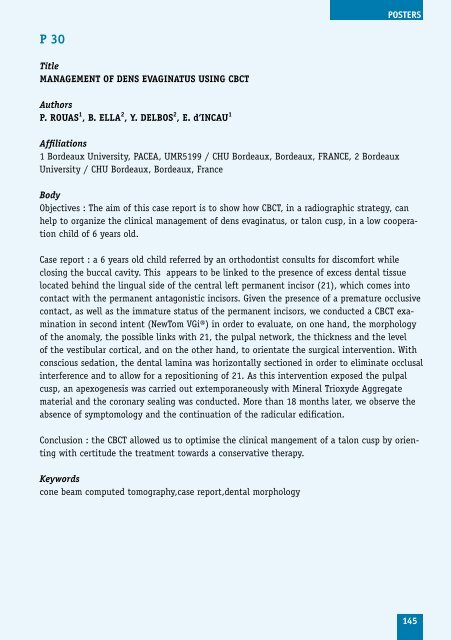Program including abstracts as pdf available here
Program including abstracts as pdf available here
Program including abstracts as pdf available here
You also want an ePaper? Increase the reach of your titles
YUMPU automatically turns print PDFs into web optimized ePapers that Google loves.
P 30<br />
Title<br />
MANAGEMENT OF DENS EVAGINATuS uSING CbCT<br />
Authors<br />
P. ROuAS 1 , b. ELLA 2 , y. DELbOS 2 , E. d‘INCAu 1<br />
Affiliations<br />
1 Bordeaux University, PACEA, UMR5199 / CHU Bordeaux, Bordeaux, FRANCE, 2 Bordeaux<br />
University / CHU Bordeaux, Bordeaux, France<br />
Body<br />
Objectives : The aim of this c<strong>as</strong>e report is to show how CBCT, in a radiographic strategy, can<br />
help to organize the clinical management of dens evaginatus, or talon cusp, in a low cooperation<br />
child of 6 years old.<br />
C<strong>as</strong>e report : a 6 years old child referred by an orthodontist consults for discomfort while<br />
closing the buccal cavity. This appears to be linked to the presence of excess dental tissue<br />
located behind the lingual side of the central left permanent incisor (21), which comes into<br />
contact with the permanent antagonistic incisors. Given the presence of a premature occlusive<br />
contact, <strong>as</strong> well <strong>as</strong> the immature status of the permanent incisors, we conducted a CBCT examination<br />
in second intent (NewTom VGi®) in order to evaluate, on one hand, the morphology<br />
of the anomaly, the possible links with 21, the pulpal network, the thickness and the level<br />
of the vestibular cortical, and on the other hand, to orientate the surgical intervention. With<br />
conscious sedation, the dental lamina w<strong>as</strong> horizontally sectioned in order to eliminate occlusal<br />
interference and to allow for a repositioning of 21. As this intervention exposed the pulpal<br />
cusp, an apexogenesis w<strong>as</strong> carried out extemporaneously with Mineral Trioxyde Aggregate<br />
material and the coronary sealing w<strong>as</strong> conducted. More than 18 months later, we observe the<br />
absence of symptomology and the continuation of the radicular edification.<br />
Conclusion : the CBCT allowed us to optimise the clinical mangement of a talon cusp by orienting<br />
with certitude the treatment towards a conservative therapy.<br />
Keywords<br />
cone beam computed tomography,c<strong>as</strong>e report,dental morphology<br />
POSTerS<br />
145


